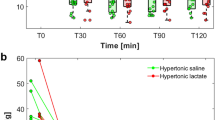Abstract
THE mechanism by which the volatile anaesthetics induce narcosis and anaesthesia remains the subject of speculation. Similarly, there has been much controversy concerning the mechanisms by which raised pressures of air or the chemically inert noble gases xenon, krypton, argon, neon and helium produce euphoria or loss of consciousness. Among the possibilities considered which could interfere with cerebral electrical activity have been a histotoxic hypoxia, depression of metabolism, membrane stabilization or block, interference with the sodium pump mechanism, increased production of inhibitor substance, interference with adenosine triphosphate production and the formation of clathrates1–6.
This is a preview of subscription content, access via your institution
Access options
Subscribe to this journal
Receive 51 print issues and online access
$199.00 per year
only $3.90 per issue
Buy this article
- Purchase on Springer Link
- Instant access to full article PDF
Prices may be subject to local taxes which are calculated during checkout
Similar content being viewed by others
References
Miller, K. W., Paton, W. D. M., and Smith, E. B., Nature, 206, 574 (1965).
Latner, A. L., Proc. Roy. Soc. Med., 58, 895 (1965).
Pittinger, C. B., and Keasling, H. H., Anesthesiology, 20, 204 (1959).
Butler, T. C., Pharmacol. Rev., 2, 121 (1950).
Featherstone, R. M., and Muehlbaecher, C., Pharmacol. Rev., 15, 97 (1963).
Bennett, P. B., The Aetiology of Compressed Air Intoxication and Inert Gas Narcosis (Pergamon Press, London, 1966).
Paton, W. D. M., and Speden, R. N., Brit. Med. Bull., 21, 44 (1965).
McIlwain, H. in Ciba Foundation Symposium jointly with Coordinating Committee for Symposia on Enzymes and Drug Action (edit. by Mongar. J. L., and Reuck, A. V. S. de), 170 (Churchill, London, 1962).
Mullins, L. J., Chem. Rev., 54, 289 (1954).
Bangham, A. D., Standish, M. M., and Miller, N., Nature, 208, 1295 (1965).
Clements, J. A., and Wilson, K. M., Proc. U.S. Nat. Acad. Sci., 48, 1008 (1962).
Papahadjopoulos, A. D., Bennett, P. B., Bangham, A. D., and Miller, L. (in the press).
Schales, O., and Schales, S. S., in Microanalysis in Medical Biochemistry (edit. by Wootton, I. D. P.), 67 (Churchill, London, 1964).
Bennett, P. B., Electroenceph. Clin. Neurophysiol., 17, 388 (1964).
Citron, L., Exley, D., and Hallpike, C., Brit. Med. Bull., 12, 101 (1956).
Bennett, P. B. thesis, Univ. Southampton (1963).
Kaplan, S. A., and Stein, S. N., Amer. J. Physiol., 190, 166 (1957).
Bennett, P. B., Life Sci., 1, 721 (1962).
Wood, J. D., Stacey, N. E., and Watson, W. J., Canad. J. Physiol. and Pharmacol., 43, 405 (1965).
Woodbury, D. M., Rec. Prog. Hormone Res., 10, 65 (1954).
Hoagland, H., Rec. Prog. Hormone Res., 10, 29 (1954).
Leiderman, P. H., and Katzman, R., Amer. J. Physiol., 175, 271 (1953).
Author information
Authors and Affiliations
Rights and permissions
About this article
Cite this article
BENNETT, P., HAYWARD, A. Electrolyte Imbalance as the Mechanism for Inert Gas Narcosis and Anaesthesia. Nature 213, 938–939 (1967). https://doi.org/10.1038/213938a0
Received:
Revised:
Published:
Issue Date:
DOI: https://doi.org/10.1038/213938a0
This article is cited by
Comments
By submitting a comment you agree to abide by our Terms and Community Guidelines. If you find something abusive or that does not comply with our terms or guidelines please flag it as inappropriate.



